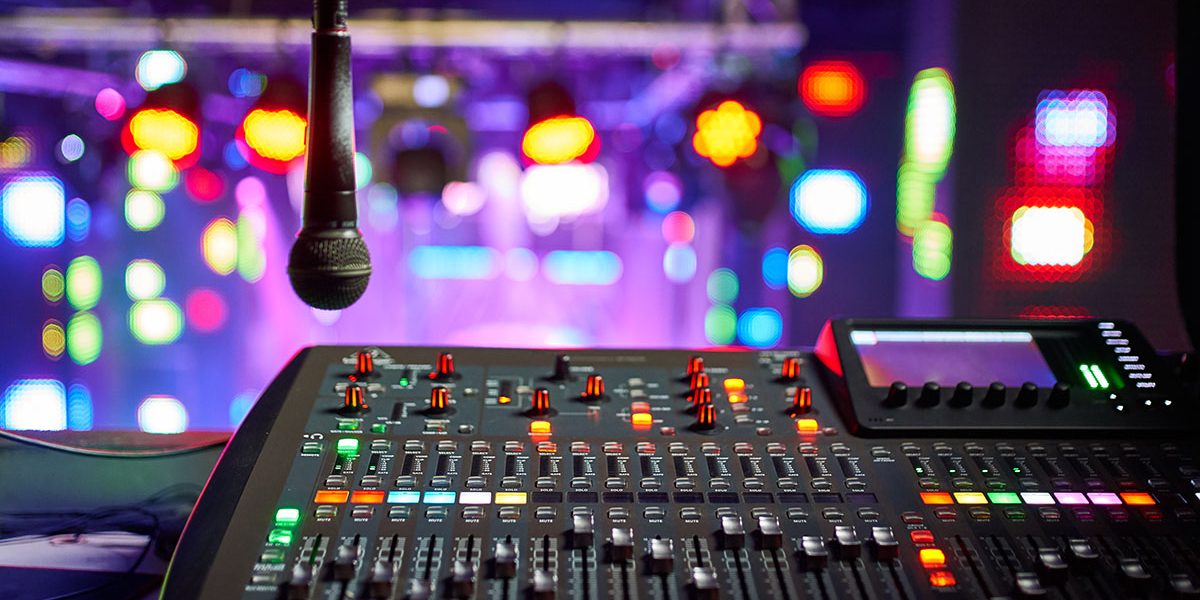How you can optimize modern gatherings with audio visual charlotte nc
Wiki Article
Understanding the Addition of Audio Visual Technology in Today's Educational Environments
The assimilation of audio-visual innovation in instructional settings has transformed the training and finding out procedure. Educators currently have accessibility to devices that cater to different finding out styles, improving student engagement and collaboration. The incorporation of these technologies provides both chances and obstacles. Understanding exactly how to properly execute these devices is important. What approaches can educators employ to maximize the advantages of audio-visual modern technology in their classrooms?The Advancement of Audio-Visual Innovation in Education And Learning
As instructional needs evolved over the years, audio-visual technology underwent substantial improvements that improved the understanding environment. Initially, devices such as movie projectors and slide programs were the key means of integrating visual elements into class. These early technologies given teachers with the ability to existing details dynamically, yet they were restricted in accessibility and interactivity.With the introduction of videotape recorder in the 1970s, classrooms began to integrate taped lessons, broadening the range of academic sources. The intro of computers in the 1980s more reinvented this landscape, permitting the creation of multimedia discussions and interactive discovering experiences.
The surge of the internet in the 1990s marked an essential minute, allowing real-time access to a wealth of audio-visual products. Today, digital devices such as interactive whiteboards and on-line discovering platforms continue to enhance the educational experience, cultivating involvement and cooperation amongst learners.
Benefits of Audio-Visual Devices for Diverse Understanding Styles
Audio-visual tools play an essential duty in accommodating varied learning styles by enhancing aesthetic knowing and enhancing auditory interaction. By incorporating pictures, videos, and audio, these modern technologies create an even more comprehensive educational atmosphere. This multifaceted approach allows instructors to address the different choices and needs of students efficiently.Enhancing Visual Knowing
Involvement in the understanding process is markedly enhanced through making use of audio-visual devices, satisfying various discovering styles. These devices, such as video clips, infographics, and interactive discussions, supply aesthetic stimuli that assist comprehension and retention. Visual students, particularly, gain from the unification of pictures and computer animations, which can simplify complex ideas and boost understanding. Furthermore, audio-visual resources can show real-world applications, making discovering more relevant and appealing. By integrating color, motion, and sound, educators can create a dynamic discovering setting that captures trainees' attention and fosters much deeper cognitive connections. Eventually, the strategic use audio-visual technology not only sustains aesthetic knowing however also enhances the general academic experience for diverse learners.Improving Auditory Engagement
A significant benefit of incorporating audio-visual tools in education is their capacity to enhance auditory involvement among pupils. These devices, which incorporate multimedia discussions, podcasts, and interactive audio elements, cater to various discovering designs, especially benefiting auditory learners (audio visual charlotte nc). By integrating noise and narration, instructors can develop immersive experiences that catch pupils' interest and strengthen comprehension. This involvement is important, as it fosters a much deeper understanding of the material and advertises retention. Additionally, audio-visual devices can promote joint knowing atmospheres, encouraging students to get involved in conversations and share their understandings. Eventually, the unification of audio-visual innovation not only supports acoustic involvement but likewise enriches the total instructional experience, making finding out more dynamic and efficient for all traineesEnhancing Involvement Via Interactive Discovering

Gamification components, such as tests and simulations, can improve motivation and retention, making learning extra enjoyable and efficient. These approaches not just stimulate cognitive engagement yet also satisfy varied learning styles, guaranteeing that all pupils can get involved meaningfully. Therefore, interactive discovering environments cultivate a feeling of community and belonging, eventually resulting in boosted academic end results. With the assimilation of audio aesthetic modern technology, teachers can change typical classrooms right into vivid areas where pupils prosper and actively shape their academic journeys.
Bridging Theory and Technique With Multimedia Resources
Multimedia sources serve as a critical link between academic concepts and practical application in instructional settings. By enhancing engagement, assisting in collective discovering experiences, and supporting varied understanding designs, these tools create an extra comprehensive and dynamic learning setting - audio visual charlotte nc. This method not only fosters much deeper understanding but likewise prepares pupils for real-world difficulties
Enhancing Engagement Via Multimedia
Involvement in instructional setups significantly enhances when teachers incorporate multimedia resources right into their mentor techniques. The usage of video clips, podcasts, and interactive discussions enhances the learning experience, permitting pupils to connect with the material on several degrees. Multimedia sources cater to numerous finding out styles, supplying aesthetic, auditory, and kinesthetic stimulations that can hold pupils' interest better than conventional lecture methods. Additionally, these resources can simplify complex concepts, making them much more easily accessible and memorable. By incorporating multimedia, instructors can create a vibrant class atmosphere that promotes curiosity and encourages students. Inevitably, the calculated use of audio-visual innovation offers to link the gap in between academic expertise and sensible application, enhancing the academic experience for both trainers and students.Facilitating Collaborative Understanding Experiences
Countless researches suggest that collective knowing experiences noticeably boost trainee outcomes when integrated with multimedia resources. Multimedia tools promote interaction amongst students, permitting them to take part in analytic and crucial thinking jointly. By making use of video clip conferencing, collaborative platforms, and interactive presentations, instructors create atmospheres favorable to synergy and shared knowing. These technologies make it possible for students to connect their ideas successfully and receive instant feedback, promoting a much deeper understanding of the subject. Additionally, multimedia sources can provide intricate ideas in even more absorbable formats, advertising conversation and partnership. Consequently, the combination of collective knowing and audio-visual technology not only improves the educational experience yet additionally prepares trainees for real-world synergy characteristics, highlighting the relevance of teamwork and collective knowledge construction.Sustaining Diverse Understanding Styles
While traditional teaching methods typically satisfy a minimal variety of learning preferences, the combination of audio-visual innovation uses a more comprehensive method to education and learning. By using multimedia sources such as videos, interactive simulations, and digital presentations, teachers can attend to different finding out styles, including visual, auditory, and kinesthetic. This flexibility permits differentiated instruction, making it possible for pupils to involve with web content in ways that resonate with their individual choices. In addition, audio-visual tools can facilitate deeper understanding by giving several depictions of complex ideas. As an outcome, pupils who might deal with standard methods can locate different pathways to success, promoting an extra equitable understanding atmosphere that supports scholastic achievement for all students.Obstacles in Applying Audio-Visual Modern Technology
Although audio-visual modern technology holds great assurance for enhancing academic experiences, its execution often runs into significant obstacles. One primary problem is the financial burden related to getting and maintaining such devices, which can strain budgets, specifically in underfunded organizations. In addition, poor training for educators can impede reliable assimilation, leaving them ill-prepared to use the innovation completely. Technical concerns, such as software program malfunctions and compatibility troubles, might also interrupt lessons and annoy both educators and pupils. In addition, differing levels of student accessibility to modern technology outside the class can produce variations in discovering opportunities. The capacity for over-reliance on modern technology may detract from crucial mentor approaches, eventually restricting the instructional experience. Dealing with these challenges needs a complete approach, consisting of appropriate funding, expert growth, and equitable access to resources, to guarantee that audio-visual technology can be leveraged properly in today's instructional settings.Finest Practices for Integrating Innovation in the Classroom

Additionally, cultivating an interactive environment via collective devices urges trainee engagement and participation. Using varied audio-visual resources deals with various learning designs, fitting visual, acoustic, and kinesthetic students. On a regular basis examining the impact of innovation on student knowing helps instructors refine their techniques and adjust to transforming needs. Ultimately, including trainees in the choice of innovation advertises ownership and inspiration. By adhering to these finest methods, instructors can develop a dynamic class ambience that effectively integrates innovation and improves the instructional experience for all students.
The Future of Audio-Visual Innovation in Education And Learning
As class significantly accept technology, the landscape of audio-visual tools in education and learning proceeds to evolve (audio visual charlotte nc). Future innovations are anticipated to concentrate on higher interactivity and customization, allowing instructors to customize discovering experiences to specific trainee requirements. Developments such as augmented fact (AR) and online fact (VIRTUAL REALITY) will likely provide immersive learning environments, enhancing trainee involvement and understanding
In addition, synthetic knowledge (AI) is poised to play a substantial function in audio-visual technology by providing real-time responses and flexible discovering pathways. This integration may help instructors recognize and attend to trainee obstacles extra properly. Cloud-based systems will help with easier accessibility to sources and collaboration among pupils and teachers, no matter location.
Along with these technological advances, specialist advancement for instructors will be essential, guaranteeing they are geared up to use these tools successfully. Overall, the future of audio-visual technology in education and learning promises to develop more dynamic, inclusive, and impactful discovering experiences.
Often Asked Concerns
Just How Can Educators Select the Right Audio-Visual Devices for Their Classrooms?
Picking suitable audio-visual devices requires educators to examine their educational goals, take into consideration student needs, review readily available innovation, and look for referrals from peers or professionals, ensuring tools properly enhance knowing and engagement within their details class environment.What Budget Considerations Are There for Implementing Audio-Visual Innovation?
Budget factors to consider for executing audio-visual modern technology include preliminary acquisition expenses, maintenance expenditures, training for personnel, and potential software licensing fees. Furthermore, long-lasting investment in updates and replacements need to likewise be factored into financial preparation.Are There Certain Training Resources for Educators on Audio-Visual Tools?
Many establishments provide training sources for instructors on audio-visual tools, including on-line training courses, workshops, and training guides. These sources intend to improve educators' skills and self-confidence in efficiently incorporating modern technology right into their mentor techniques.Just how Do We Measure the Performance of Audio-Visual Technology in Understanding?
Measuring the efficiency of audio-visual innovation in learning includes examining student involvement, comprehension, retention prices, and overall academic performance. Studies, assessments, and observational studies can provide valuable understandings into its influence on academic results.What Prevail Misunderstandings Concerning Audio-Visual Modern Technology in Education And Learning?
Common misconceptions regarding audio-visual modern technology in education and learning consist of the belief that it ensures interaction and finding out end results, along with here the assumption that all pupils benefit similarly, overlooking private discovering preferences and needs.Report this wiki page